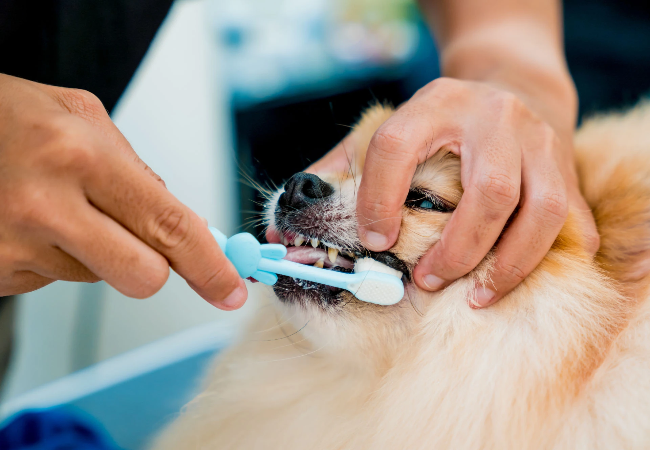A Vet’s Guide to Dog Teeth & Dental Health 2025 🦷

In this article
A Vet’s Guide to Dog Teeth & Dental Health 2025 🦷
By Dr. Duncan Houston BVSc
Hi there, I’m Dr Duncan Houston BVSc, a veterinarian and founder of Ask A Vet. In my years of practice, I’ve seen how crucial dental health is to a dog’s wellbeing—from puppyhood to their senior years. Poor oral hygiene isn’t just bad breath; it can lead to heart, kidney, and liver disease. This complete, vet-approved guide explores dental anatomy, teething stages, common dental diseases, and prevention strategies—all backed by clinical experience and leading veterinary sources. 🩺🐾
1. How Many Teeth Do Dogs Have?
Adult dogs have 42 permanent teeth: 20 in the upper jaw (maxilla) and 22 in the lower jaw (mandible). Puppies, meanwhile, have 28 deciduous “baby” teeth, which erupt between 3–6 weeks of age.
2. Puppy Teething Timeline & Care
- Birth–2 weeks: No visible teeth.
- 3–4 weeks: Deciduous incisors erupt.
- 4–6 weeks: Canines and premolars appear; a total 28 baby teeth by 6–8 weeks.
- 12–16 weeks: Deciduous teeth start falling out; adult teeth come in.
- 5–7 months: All 42 adult teeth are typically present; large breeds may take longer.
Teething often causes discomfort—aches, chewing, drooling, or moodiness. Offer safe chew toys like Nylabone rings, KONG toys, and chilled carrot sticks to ease pain.
3. Tooth Anatomy & Function
Dogs’ teeth are specialized:
- Incisors (12): Front teeth for grooming, nibbling.
- Canines (4): Fang-like; grip and tear meat.
- Premolars (16): Crush and shear food.
- Molars (10): Grind tougher food.
Understanding each tooth’s role helps you care for specific dental issues like fractures of canines or retained baby incisors.
4. Common Dental Problems
4.1 Retained Deciduous Teeth
If baby teeth don’t fall out, adult teeth erupt beside them, causing crowding, infections, and misalignment—especially in small breeds. Professional extraction is often needed.
4.2 Periodontal Disease & Bad Breath
Plaque hardens into tartar, inflaming gums (gingivitis) and leading to periodontitis—painful, and linked to systemic disease. Signs include bad breath, red gums, loose teeth, and refusal to chew.
4.3 Tooth Fractures
Biting hard objects (bones, antlers) can crack enamel or expose pulp. Watch for chewing on one side, drooling, or bleeding.
4.4 Loose Adult Teeth & Abscesses
Loose adult teeth may signal advanced periodontal disease. Abscesses manifest as swelling, pain, or bad taste. Veterinary care is essential.
4.5 Malocclusion
Misaligned bites (overjet, underbite) can cause trauma or uneven wear. May require extraction or orthodontic adjustment.
5. When to See a Vet 🩺
Veterinary evaluation is needed if your dog shows:
- Consistent bad breath (beyond “wet dog”)
- Gum bleeding, swelling, recession
- Painful chewing or facial swelling
- Loose adult teeth or persistent retained baby teeth
- Excessive drooling, reluctance to eat, or nose discharge
We perform detailed oral exams—often under sedation—with full dental charting and X-rays for hidden issues.
6. Vet-Approved Prevention Strategies
6.1 Teeth Brushing 🪥
Brush at least 2–3× weekly to reduce plaque; ideal is daily. Use canine toothpaste and soft brushes, introduce slowly with positive treats.
6.2 Chews & Diets
VOHC-approved dental chews help reduce tartar. Offer safe options like rubber toys, rawhide alternatives, and large carrots (freezer-chilled). Avoid hard bones or hooves.
6.3 Water Additives & Wipes
Additives with chlorhexidine or zinc reduce bacteria; dental wipes are a quick, effective alternative when brushing isn’t possible.
6.4 Professional Dental Cleanings
Annual sedation-based cleanings are vital—only they clean beneath the gumline. More frequent visits for those with early periodontal disease.
7. Managing Puppy Teething
Puppy teething is a critical phase:
- Offer age-appropriate chew toys (KONG Puppy, Nylabone rings).
- Freeze toys/gauze to soothe gums.
- Maintain vet check-ups around 12–16 weeks for development and retained teeth screening.
- Build brushing habits early—even finger brushing fosters tolerance.
8. Enrichment for Dental Health
Combining oral care with mental stimulation boosts well-being:
- Frozen Kong Treats: Soothing and beneficial for teething puppies.
9. Real Case Study 🧑⚕️
Case: Max, 4-year-old Labrador Retriever
Max was suffering from halitosis and bleeding gums. After introducing daily brushing, dental chews, and a professional cleaning, his tartar was drastically reduced and inflammation healed. Over a 6-month follow-up, Max’s vet visits showed stable dental health. This shows how proactive care can prevent serious disease.
10. Ask A Vet Telehealth Support
Through Ask A Vet, I offer telehealth dental consultations—for guidance on brushing, recognizing early problems, and deciding when to schedule cleanings. We also provide customized dental kits, including brushes, wipes, and sample chews.
11. Conclusion & Next Steps
Your dog deserves a healthy mouth—and your commitment to dental care makes all the difference. Follow this vet-approved plan:
- 🪥 Start brushing 2–3× weekly—aim for daily.
- 🧃 Use VOHC chews and water additives.
- 📅 Schedule annual professional cleanings.
- 📊 Monitor for bleeding gums, loose teeth, or bad breath.
- 📱 Download the Ask A Vet app for instant advice and product recommendations.






